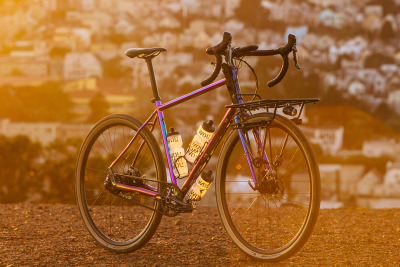The 400k brevet is generally considered the most difficult
in the Super Randonneur Series. The
increased distance over the shorter brevets can be difficult to manage physically,
particularly later in the ride. While
there are 27 hours allowed to complete a 400k, my perception is most
randonneurs push to finish the ride without stopping to sleep. Such conditions can contribute to a cumulative
fatigue that can be challenging, particularly for cyclists
new to the sport.
As Susan, Sarah, and I left Bismarck for Helana, Montana on
July 18th, the challenge of the 400k weighed heavily on my
mind. Was it worth the risk to drive 10+
hours to ride this ‘new’ brevet distance?
Assuming I could make it through the day, what traffic risks would I
face by riding during the wee hours of the morning? And finally, how would my body respond to the
smoke that covered much of Montana from fires in Canada and central Washington?
Looking back, these questions/concerns seem justified, but
were non-issues. The Roe River 400k
turned out to be an excellent experience thanks to good planning, excellent
support, and favorable riding conditions. And with a finishing time of
20:58, it may perhaps be the fastest 400k I’ll ever ride.
Beginning in north Helena, the route followed I-15 to Wolf
Creek for a long clockwise tour on mostly quiet, two-lane roads through
Augusta, Fairfield, Simms, Great Falls, and Cascade before returning to Wolf
Creek for the final 30 miles back to north Helena. It was a challenging route, with about 9000 feet
of climbing and significant distances between controls. Jason Karp, Montana’s RBA, mentioned the
route was PBP-like, minus the tree-lined roads.
(Daybreak, south of Wolf Creek)
(Big Sky! Highway 434, heading north to Augusta)
(Time to refuel at the Augusta Trading Post)
(Anheuser-Busch grain storage in Fairfield)
(The great falls in Great Falls)
(The Roe River... ...in all its 201 feet of glory)
Conditions for the ride were ideal for the clockwise route;
at least for nearly all of the first 165 miles.
A moderate- to strong south/southwest wind aided the riding effort, and
provided a co-benefit by clearing the smoky skies by the time we left Great
Falls for the return to Helena (a leg that proved difficult given the
significant headwind, though the clear, star-filled sky more than made up for
it once we were riding in the dark).
Much like the Fishtail 300k, I found the traffic courteous with the
exception of a couple sub-five foot passes (one of which involved
a Montana state patrol car).
My riding companions for the day included Jason and Ken. We rode together for nearly the whole route. Similar to the 300k, I was the fortunate beneficiary
of their strong riding, quick wit, and positive focus when we were all
suffering. Additionally, we seemed to be
‘in-sync’ throughout the day, sharing a similar riding pace for nearly the entire ride.
(Riding companions for the day - Jason to the left and Ken to the right)
Aside from one flat early in the day and a few interesting
wildlife interactions, we enjoyed a smooth, uninterrupted ride. As for the latter, we shared the road with a
confused antelope near Cascade (who, fortunately, ran away from us), and I
nearly ran over a rattlesnake while daydreaming along the frontage road north
of Wolf Creek. Ken and I were also chased
by a pug for about 50 yards early in the ride (I can handle being chased by
that breed of dog… …a non-threat, even
at 10 mph).
This was my first brevet where I did not break for a
sit-down meal, though we took ample time in Augusta, Simms, Cascade and later
in Wolf Creek to refuel with food and drink.
The stop in Wolf Creek, with much thanks to Jason’s wife, son, and
mother-in-law, was timed perfectly given we had been on the road for over 18
hours.
My pace dropped off considerably after midnight, perhaps a
reflection of the cumulative physical/mental fatigue brought on by the 400k
distance. The final climb back to Helena
even found me walking my bike for a short stretch (and goodness, did it ever
feel good to walk for a while!).
Other miscellaneous reflections…
· Issues with my right knee were managed nicely by
ibuprofen. Only four tablets were needed
during the ride.
· Tightness/pain in my upper back came and went
throughout the ride, suggesting an underlying psychological driver to this
physical response. Also, I felt better
on this ride than the 300k. Accordingly,
a switch in Nitto stems prior to the ride (resulting in a more upright position) had
the desired effect.
· Riding along the Missouri river was a wonderful
experience, despite being constantly pelted by an array of flying insects. I’m fairly certain I could repeatedly ride
the stretch from Cascade to Wolf Creek and never tire of the scenery.
· Helena is a good destination for the
family. I returned to a positive review
of the downtown and surrounding countryside.
We’ll return in the future, hopefully for a longer stay.
(Looking down on the Missouri)
(Now along the Missouri river, somewhere north of Wolf Creek)
With completion of this 400k, I’m now a 600k brevet from
Super Randonneur status for 2014. My
work schedule won’t allow me to return to Montana to complete the series, which
will pass over Beartooth pass on Labor Day weekend (that will be a ride
for another year!). Instead, I’ll be off
to Minnesota mid-September for the Tour d’Twin Cities.
All for now. If you’d
like to read another excellent ride review by Jason Karp, I encourage you to
visit belgradebobcat.blogspot.com.

































